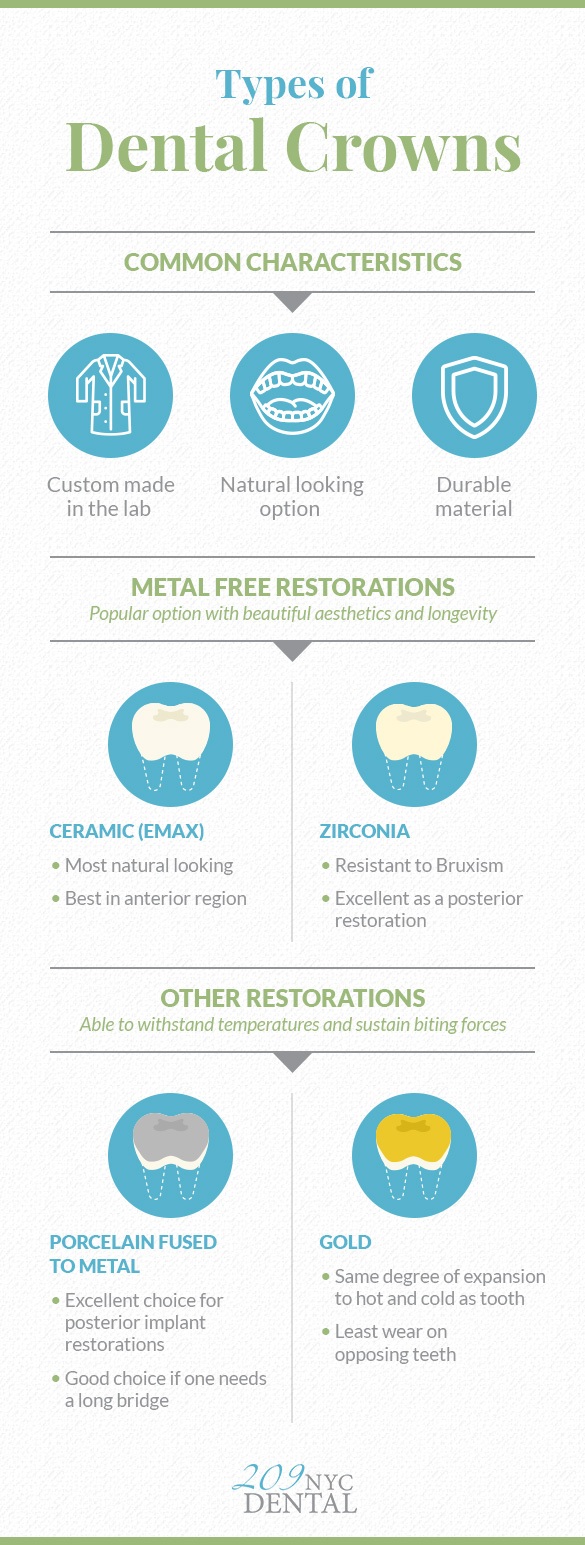Porcelain Crowns and Bridges in NYC
Guide to Dental Crowns: Description, Types & Cost in NYC
Dental crowns are a crucial aspect of modern dentistry, providing versatile solutions to various dental issues. A dental crown, also known as a tooth crown, covers several dental procedures that address the same or similar needs but are made using different dental materials. Samples of the cost and types of dental crowns are ceramic, porcelain, gold, porcelain-fused-to-metal, stainless steel, and implant crowns.
These dental fixtures play a pivotal role in enhancing teeth’ functionality and appearance, addressing a range of dental concerns. Here, we will explore the types of dental crowns, their costs, benefits, and essential considerations. Understanding the significance of porcelain crowns and bridges in NYC is key to making informed decisions about oral health treatments and achieving a confident, healthy smile.
- Dental Crown Procedure, Cost, and Types
- Porcelain Dental Crown Cost in NYC
- Types of Dental Crowns
- When Do I Need a Dental Crown?
- Dental Crown Procedure: Step by Step Guide
- 209 NYC Dental
209 NYC Dental in Midtown East Manhattan offers a wide array of options for replacing missing teeth, broken teeth, and compromised teeth, including comfortable, natural-looking porcelain crowns and bridges in NYC to help patients improve their smiles and feel more confident in how they look.
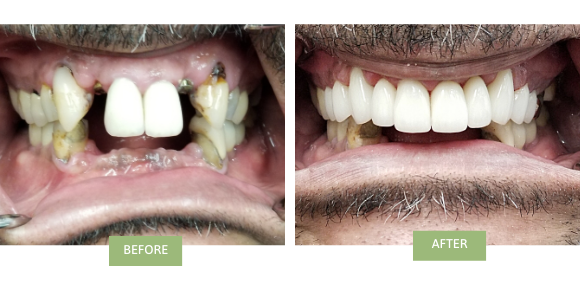
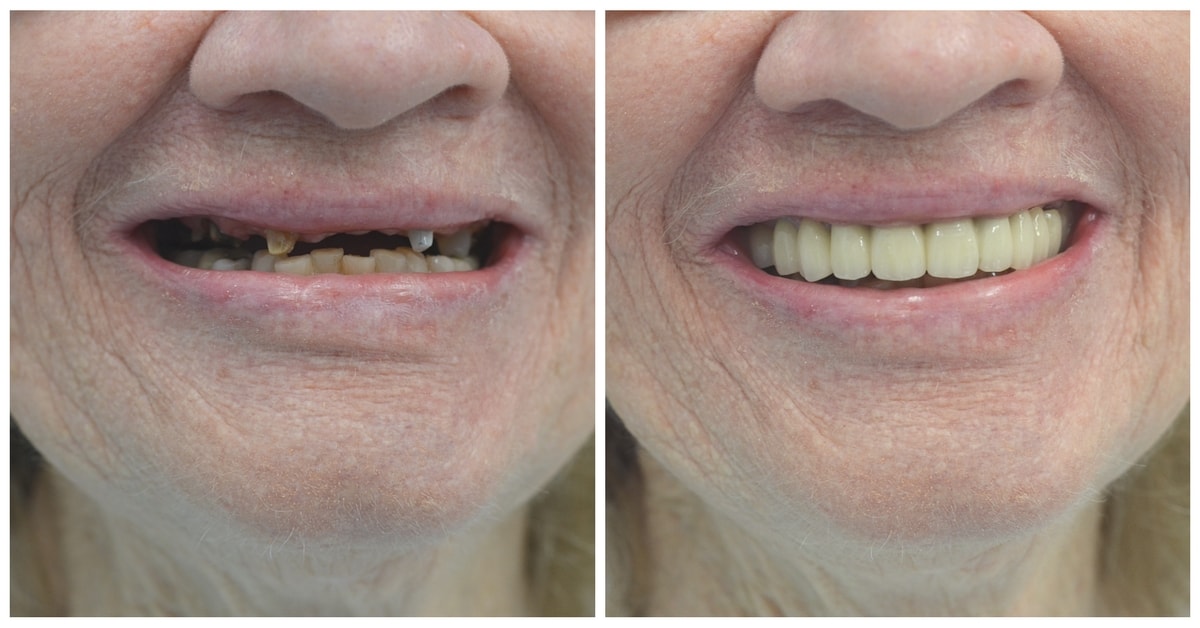

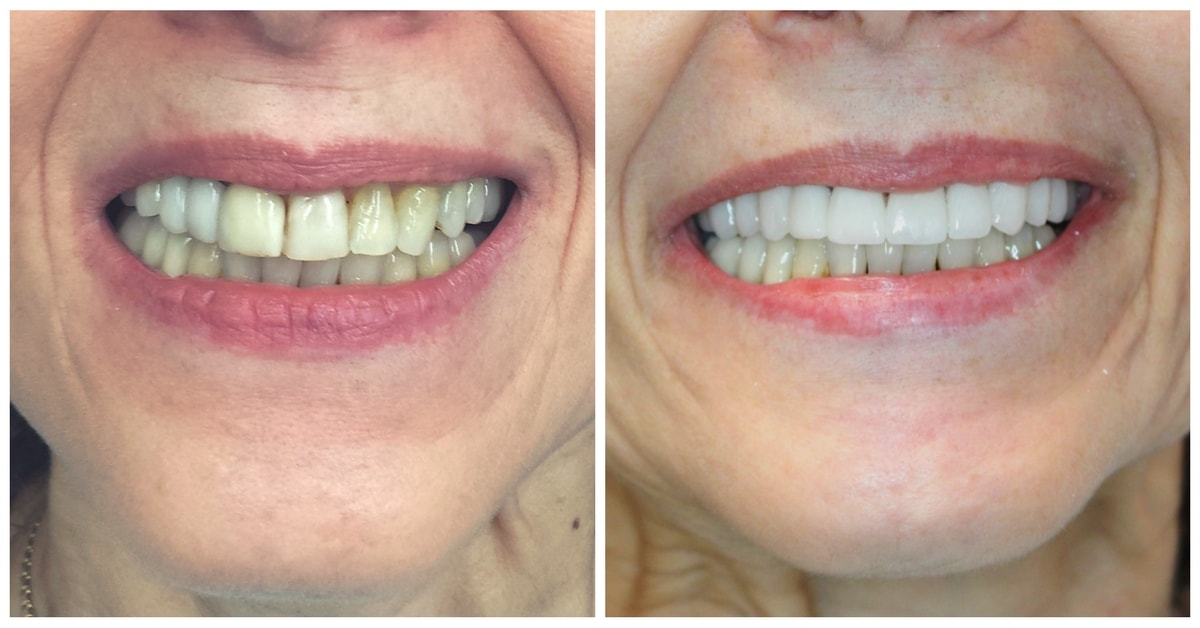
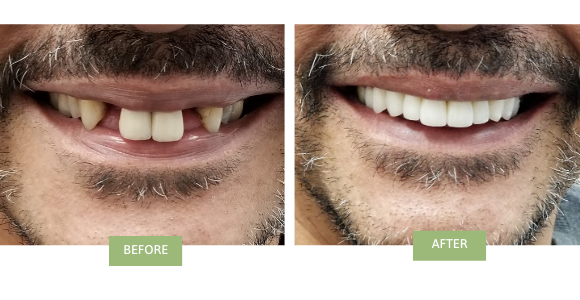
What is Tooth Crown?
The anatomical tooth crown is the natural, visible part of a tooth covered by enamel, extending from the gumline to the tip. It includes enamel, dentin, and the pulp chamber; its features vary depending on the tooth type. The anatomical crown is a natural component of the tooth within the oral cavity.
On the other hand, a dental crown, often referred to by patients as a tooth crown, is a prosthetic restoration designed to replicate and replace the anatomical tooth crown when a more natural tooth structure is damaged.
What is a Dental Crown?
Dental crowns are versatile dental restorations that encase damaged or weakened natural teeth, restoring their strength, shape, and functionality. These tooth-shaped caps are individually made in the dental lab. They are crafted to fit over the entire visible portion of the tooth structure, providing structural support and an aesthetically pleasing appearance.
Dental crowns are permanent, so they require significant skills and are performed by a licensed dentist. Depending on the patient’s needs and concerns, dentists determine the cost and types of dental crowns best suited for each case.
When Do I Need a Dental Crown?
Understanding the proper treatment for each type of dental damage is essential. In the dental arsenal of procedures, we have dental bondings, ceramic onlays and inlays, porcelain crowns, and bridges in NYC to restore most of the damage caused by decay or fractures or to enhance one’s smile.
Why is a dental crown needed when so many more conservative replacement options are available to restore a damaged natural tooth structure? Covering the entire tooth with a dental crown is the best treatment option in various scenarios. Understanding when to consider porcelain crowns and bridges in NYC is crucial for optimal oral health.
- Significant Tooth Decay: Significantly decayed teeth that have lost many natural tooth structures become susceptible to future fractures if not restored properly. Fillings or porcelain onlays may not obtain proper retention to provide long-lasting results. A dentist may recommend placing porcelain crowns and bridges in NYC over weak teeth in a case like this.
- Broken Tooth or Cracked Tooth: Sometimes, a severely broken tooth is missing more of its natural structure than it has remaining. In this case, the dental crown can support this weak tooth and restore its full functionality by replacing the missing tooth structure.
- Root Canal Treatment (RCT): If you need root canal treatment or therapy, you should restore this damaged tooth with a dental crown. After the root canal, the tooth becomes brittle and may break under biting pressure. Thus, a dental crown is commonly recommended to protect the treated tooth and prevent more damage to the tooth structure.
- Cosmetic Enhancement: In addition to dental veneers, porcelain crowns, and bridges are used for cosmetic purposes in NYC, such as improving the appearance of discolored, misshapen, or severely stained teeth.
- Support for Dental Bridges as Abutment teeth: Dental crowns serve as anchors for dental bridges, helping to replace missing teeth and restore a complete, functional dental arch.
- Implant Crown Restoration: Dental crowns are utilized to restore teeth that have been replaced with dental implants, providing a natural-looking and functional replacement.
- Replacing an Old Crown: If an old dental crown needs to be replaced due to fracture, decay, or cosmetic reasons, a new crown is the only option.
Read our porcelain and composite fillings article to learn about other suitable options to restore tooth decay or tooth fracture. Our porcelain veneers article can help you explain why dental veneers are considered the best treatment.
Common Types of Dental Crowns
There are many types of dental crowns and costs. They can also describe the types of dental materials used to create crowns, but the concept and process are the same from the patient’s standpoint.
A dental crown can be made from different materials, such as gold, ceramic, metal alloys, and porcelain fused to metal. All-porcelain, ceramic, and porcelain-fused-to-metal crowns are fabricated to match the natural tooth color.
All–Ceramic & All-Porcelain Crowns
All ceramic and all-porcelain crowns are dental crowns. The entire crown is made without the use of metals. All-porcelain crowns usually have the most natural-looking color and are excellent choices for front teeth or as an alternative for those with metal allergies. They offer a lifelike translucency that mimics natural tooth enamel. However, porcelain crowns and bridges in NYC can wear down over time and are not the most potent option.
Emax Crowns
Emax (“ee-max”) is a brand name for a type of dental ceramic often used to create porcelain crowns and bridges in NYC. Emax crowns are known for their aesthetic qualities, strength, and durability. They are also known as lithium disilicate crowns, which are made of glass ceramic material.
Emax crowns are typically fabricated using advanced computer-aided design and computer-aided manufacturing (CAD/CAM) technology, which ensures precise and customized results. Dentists may recommend Emax crowns based on the patient’s specific needs, considering the tooth’s location, bite, and aesthetic preferences.
Zirconia Crowns
Zirconia crowns are long-lasting and strong, putting less stress and wear on the opposing teeth. They are not likely to cause allergic reactions. However, due to their strength and adherence to the tooth, Zirconia crowns may be more complex to remove if additional treatment is needed. Zirconia crowns are more opaque than porcelain crowns and bridges in NYC, but they might be a better choice if you are a bruxer.
Porcelain Crowns vs Ceramic Crowns
The terms “porcelain” and “ceramic” are sometimes used interchangeably in dentistry, but there are distinctions between them, particularly in the context of dental crowns:
- All-Porcelain Crown: A dental crown made entirely of porcelain. All-porcelain crowns are a subset of ceramic crowns. These crowns are known for their natural tooth-like appearance, as porcelain can be color-matched to the patient’s existing teeth. Porcelain crowns and bridges in NYC are commonly used for front teeth due to their aesthetic qualities.
- Ceramic Crowns: The term “ceramic crown” is broader and can encompass various ceramic materials used in dental restorations, including porcelain. Ceramic crowns may be composed of different ceramics, such as zirconia or lithium disilicate. These materials offer strength and durability while providing a natural look.
Porcelain-Fused-to-Metal Crowns (PFM Crowns)
Porcelain-fused-to-metal crowns, also called PFM crowns, are natural-colored and can be color-matched to the surrounding teeth. As the name implies, they have a porcelain coating over the metal crown underneath, which can vary from base metal to high-noble metal to titanium alloy.
These crowns are a good choice for front or back teeth, but if the patient is a heavy grinder, they may chip, break off, or wear down surrounding teeth over time.
PFM crowns do not offer the same level of translucency as porcelain crowns and bridges in NYC. They can cause allergic reactions if there is sensitivity to metals. Also, with age, our gums recede, exposing the metal underneath PFM crowns and resulting in a less aesthetic appearance.
All-Metal Crowns
All-metal crowns, or full-metal crowns, are dental crowns in which the entire crown is made without any porcelain or ceramic components. Due to their strength and lack of ceramic components, these crowns are resilient and suitable for withstanding biting and chewing forces. They are also ideal for restoring teeth where biting forces are more significant, as metal crowns rarely chip.
These crowns are often crafted from gold, palladium, or nickel-chromium alloys. Compared to porcelain crowns and bridges in NYC, they typically require less tooth structure removal during preparation, preserving more of the natural tooth.
While metal crowns offer robust functionality, their metallic appearance makes them less aesthetically appealing than porcelain crowns and bridges in NYC. In addition, like PFM crowns, allergic reactions to metals are a consideration for patients with sensitivity to metals.
Gold Crowns
A gold crown is a dental crown crafted from gold or a gold alloy. It is known for its exceptional durability, biocompatibility, and resistance to wear. Typically used for molars and premolars, gold crowns require minimal removal of tooth structure during preparation.
Generally, gold crowns are more expensive than specific porcelain crowns and bridges in NYC due to the cost of dental crown types with gold alloy. Prices can range from $800 to $3,000 per new crown.
Stainless Steel Crowns
Stainless steel crowns are durable, prefabricated dental crowns commonly used in pediatric dentistry. Made from a corrosion-resistant alloy of chromium, nickel, and iron, this metal crown is pre-formed and adjusted by dentists to fit a primary tooth. Its strength and durability make it suitable for withstanding the biting forces in the back of the mouth.
Often employed as a temporary dental crown, a metallic crown offers a cost-effective and efficient means of restoring a primary tooth until it naturally falls out, making way for a permanent tooth. Due to their metallic appearance, metallic crowns are not used for permanent restorations in adult teeth. Still, they are better options than porcelain crowns and bridges in NYC pediatric dental applications.
This crown placement does not require multiple dental visits since it is not custom fabricated in a dental lab. It involves preparing the tooth, selecting the appropriate crown, and then adapting and cementing it onto it. This procedure is relatively quick and straightforward.
Resin Crowns
Resin crowns, composed of composite tooth-colored filling material, are valued for their relatively low cost among dental crown types. They require minimal tooth structure removal during placement. While resin crowns are more affordable than porcelain crowns and bridges in NYC, since they are made of the same filling material as traditional white fillings, they are more susceptible to color change, wear, and chipping over time.
Dental Implant Crowns
A dental implant crown is the visible, functional part of a dental implant. It replaces a missing tooth and is attached to an abutment, which connects it to the implanted fixture anchored in the jawbone.
The implant crown is custom-designed to match the shape, color, and size of the patient’s natural teeth, providing a natural and aesthetically pleasing appearance. Implant crowns can be all-porcelain or porcelain-fused-to-metal.
One of the key advantages of implant crowns is their stability and permanence, as they are securely anchored to the jawbone, mimicking the strength and function of a natural tooth.
The placement of porcelain crowns and bridges in NYC is a multi-stage process, beginning with the surgical placement of the implant and concluding with the attachment of the custom-made crown, ultimately restoring both the function and cosmetic aspect of the missing tooth. To learn more, check out our article about implant crowns and bridges in NYC.
Dental Crowns for the Front and Back Teeth
When a dental crown is diagnosed, dentists recommend different types of dental restoration based on the patient’s needs and concerns, such as the tooth’s position, bite, aesthetics, and metal allergies.
Porcelain-fused-to-metal crowns used to be the most popular option, but with developments in technology and advancement in porcelain crowns and bridges in NYC, dentists and patients find other types of dental crowns like Zirconia crowns and other all-ceramic crowns to be better options.
Dental Crowns on the Back Tooth
Molars and premolars endure substantial biting forces and are vital for chewing. Dental crowns are frequently employed on these teeth to strengthen and protect their load-bearing surfaces. Whether due to extensive decay, fractures, or large restorations, crowns provide durable protection and restore the tooth’s structural integrity.
Porcelain crowns and bridges are often used for back teeth in NYC. They’re selected for their strength and ability to withstand the pressures associated with chewing and grinding. Zirconia crowns, PFM crowns, all-metal crowns, and gold crowns are all suitable options for out-of-sight molars.
Dental Crowns for the Front Teeth
If you need dental crowns on your front teeth and are not a grinder, ceramic and porcelain crowns offer a natural-looking option to restore your teeth. At 209 NYC Dental, we work with a top-of-the-line dental laboratory and ceramic specialist, ensuring our results produce beautiful, natural-looking teeth. Check out our smile gallery of before-and-after porcelain crowns and bridges in NYC to judge for yourself.
Dental Crown Procedure: A Step-by-Step Guide
This section provides a detailed breakdown of the steps involved in getting a dental crown. This procedure is typically a two-visit treatment identical to porcelain onlay and inlay.
1. Diagnosis & Treatment Planning for Dental Crowns
The initial phase involves a consultation with your dentist, who will thoroughly examine your teeth. This includes using X-rays to assess the extent of damage or decay to the natural teeth. Based on this evaluation, the dentist will determine whether a crown is an appropriate treatment and, if so, the costs and types of porcelain crowns and bridges in NYC that are best suited.
2. Crown Preparation Steps:
It’s important to note that the steps may vary slightly depending on the specific circumstances and the technology used by the dental practice.
- Crown Prep: The existing tooth must be prepared before the final crown is placed. This involves removing any decayed or damaged tooth structure, including natural enamel, and shaping the remaining tooth to provide enough space so the new crown fits comfortably when cemented.
- Impressions: Once the tooth is prepared, impressions of the treated tooth and surrounding teeth are taken. This can be done using traditional dental impression material or digital scanning technology. Please note that 209 NYC Dental uses a 3D scanner for dental impressions of porcelain crowns and bridges in NYC. The doctor uses a digital wand. In addition, because we use 3D scanners, the impression time is much shorter, and your overall experience is much more pleasant.
- Temporary Crown: Since the natural tooth no longer has tooth enamel to protect it, it may become susceptible when exposed to air, water, and food. Thus, the tooth has to be protected with a temporary crown. While the permanent crown is being fabricated (which can take a couple of weeks), a temporary crown is placed to protect the prepared tooth. If multiple teeth are being prepared, every tooth will get a temporary crown. Temporary crowns are usually made of acrylic and are not as durable as permanent ones. Temporary crowns and bridges are meant to last until final porcelain crowns and bridges in NYC are cemented and need to be easily removed when the permanent crown is ready for cementation.
- Dental Lab Fabrication: The impressions or digital scans are sent to a dental laboratory, where skilled technicians create the custom crown based on the dentist’s specifications, including the shade.
3. Crown Placement:
- Temporary Crown Removal: Once the permanent crown is ready, you return to the dentist for the crown placement. The temporary crown is removed, and the fit and color of the permanent crown are checked.
- Crown Adjustments: The dentist makes necessary adjustments to ensure the crown fits properly and the patient feels comfortable biting. This may involve shaping and polishing the crown to avoid additional pressure from opposing teeth.
- Crown Cementation: Once satisfied with the fit and appearance, the dentist cements the dental crown onto the prepared tooth using dental cement. Any excess cement is removed.
- Final Checks and Instructions: The dentist ensures that the dental crown does not interfere with your bite and checks your overall satisfaction. They may also provide instructions on caring for and maintaining the crown. Always follow your dentist’s recommendations for post-procedure care and maintenance to ensure crown longevity.
Post-treatment Recommendations
Recovery Time After a Porcelain Crown Procedure?
The recovery time following a crown procedure can vary. Generally, patients may experience some sensitivity or discomfort for a few days. However, significant improvement is often noticeable within a week. For a smoother recovery after receiving porcelain crowns and bridges in NYC, it’s essential to follow post-procedure care instructions provided by your dentist.
Foods to Avoid with a Crown
You can eat normally once the anesthesia wears off after getting a permanent crown. However, it’s advisable to be cautious with very hard or chewy foods that could damage or dislodge the crown. Some examples include chewy candies, ice, and hard nuts. Opt for softer and non-sticky options to protect your new crown. Consult with your dentist for specific dietary guidelines based on your case.
Post-treatment Recommendations
Recovery Time After a Porcelain Crown Procedure?
Following a crown procedure, the recovery time can vary. Generally, patients may experience some sensitivity or discomfort for a few days. However, significant improvement is often noticeable within a week. It’s essential to follow post-procedure care instructions provided by your dentist for a smoother recovery.
Foods to Avoid with a Crown
Once the anesthesia wears off after getting a permanent crown, you can eat normally. However, it’s advisable to be cautious with very hard or very chewy foods that could potentially damage or dislodge the crown. Some examples include chewy candies, ice, and hard nuts. Opt for softer and non-sticky options to protect your new crown. Consult with your dentist for specific dietary guidelines based on your individual case.
Benefits of Dental Crowns
Dental procedures in NYC are unique to every individual’s needs, from porcelain crowns to bridges. Here are some things to consider during and after getting a tooth crown:
Cosmetic Benefits
Ceramic and all-porcelain crowns offer significant cosmetic advantages by improving the appearance of damaged, discolored, or misshapen teeth. In NYC, porcelain crowns and bridges are customized to match natural teeth’ color, shape, and size, enhancing overall smile aesthetics.
Dental crowns are protective restorations that provide a durable and strong covering for weakened natural teeth, safeguarding them from further damage, decay, or fractures. This protective function helps maintain the tooth’s structural integrity.
Disadvantages of Dental Crowns
Tooth reduction: Due to a significant reduction in tooth structure, crowns are less desired. Ceramic onlays, inlays, and porcelain veneers provide similar types of restoration while preserving more tooth structure. PFM crowns require the most reduction.
Possible crown loss: Like any restoration, a dental cap may come off for various reasons.
The unaesthetic appearance of metal: Unlike porcelain crowns and bridges in NYC, metal crowns are protective restorations with no aesthetic appeal. Eventually, the metal edge of the porcelain fused to the metal crown (PFM crowns) will start to show as the gums recede.
How to Fix a Loose Crown?
Is this a dental emergency? Yes, it is!
Do you have to be seen right away? If a crown falls off, call your dentist immediately! If you are away or the dentist’s office is closed, it is not an emergency that has to be addressed immediately unless you are in pain. You have to see a dentist to have them check the tooth, clean the crown, and re-cement it with permanent cement if there are no contradictions.
If you cannot go to the dentist? You can buy a temporary, over-the-counter cement at the nearest pharmacy and temporarily cement the crown. Please remember that this is only a temporary solution. Temporary cement does not provide the proper sterile environment that your tooth requires to avoid decaying again.
In addition, there might be an underlying reason why the crown came off, and if this issue is not resolved right away, it may cause more toothache and expense.
Porcelain Crowns and Bridges in NYC Cost
The cost of porcelain crown types can vary widely based on several factors. Here is a quick overview of what can affect the price of the crown:
- Dental Insurance or private fees: Insurance fees tend to be lower for crowns than private fees.
- Your location: The cost of living and real estate in NYC is likely much higher than that of a small town in New York.
- Type of crown: In NYC, porcelain crowns and bridges will always be more expensive than all-metal crowns and bridges.
- The procedure is complex. The final treatment plan will be more expensive if additional treatments are needed to restore the tooth.
- The individual dental practice prices: Private offices determine their prices, so one office’s price can and often does differ.
- The technology or materials dentists employ: The use of better materials may be reflected in higher costs of dental crown types since they’re often related to better quality of the supplies, instruments, and materials used. However, smaller dental offices may not have the same leverage to negotiate supply costs due to the smaller volume of dental offices or large DSO chains.
It’s essential to understand that crown costs can range from several hundred ($800) to over a thousand dollars per crown ($2,500-$3,000), and the final price may depend on various factors. Remember to prioritize the quality of dental care and materials when making decisions about your oral health. Always consult directly with a dentist in your area for the most accurate and personalized information about types of dental crowns and costs.
Contact the Specialists at 209 NYC Dental for Porcelain Crowns and Bridges in NYC
We want to help you improve your smile and self-esteem with our quality dental treatments and restoration services if you are experiencing tooth loss. Contact us today to learn more about our oral hygiene services, or book an appointment online to schedule your procedure.
209 NYC Dental is conveniently located in Midtown Manhattan and is open seven days a week, providing our patients with additional scheduling flexibility. With over twenty years of experience, we have expanded into a multi-specialty practice that can aid you with any dental issue, including porcelain crowns and bridges, all in one location.
Author: Dr. Ben Ifraimov
What Our Patients Are Saying
With over 1000 reviews from all over the web with an average rating of 4.9 we are proud to be in the Manhattan Dental Elite.
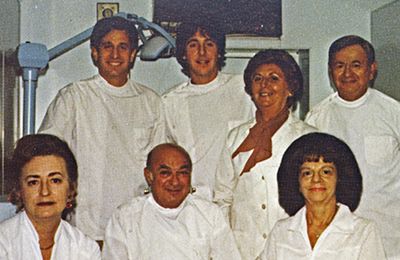 Our History
Our History
 Our Providers
Our Providers
 About Us
About Us
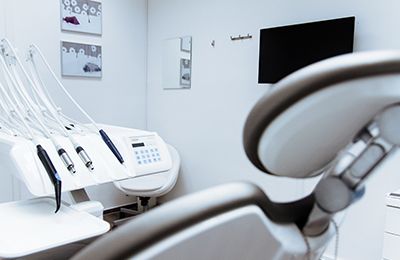 Blog
Blog
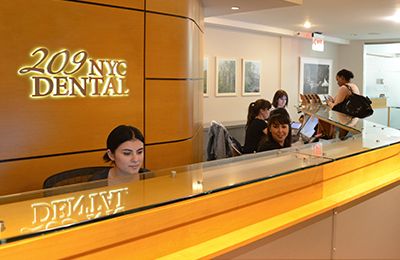 Contact us
Contact us
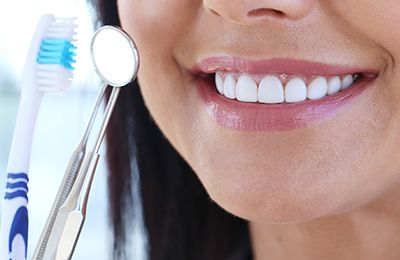 Diagnostic & Preventive
Diagnostic & Preventive
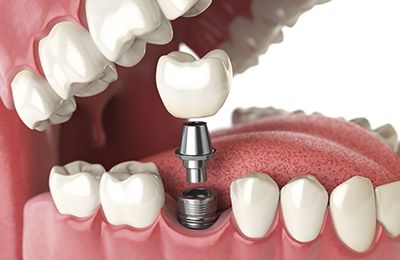 Implant Dentistry
Implant Dentistry
 Clear Braces - Invisalign
Clear Braces - Invisalign
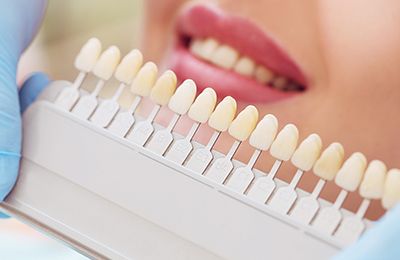 Cosmetic Dentistry
Cosmetic Dentistry
 Periodontics
Periodontics
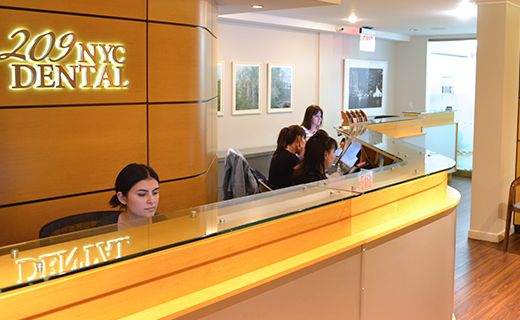 Patient Forms
Patient Forms
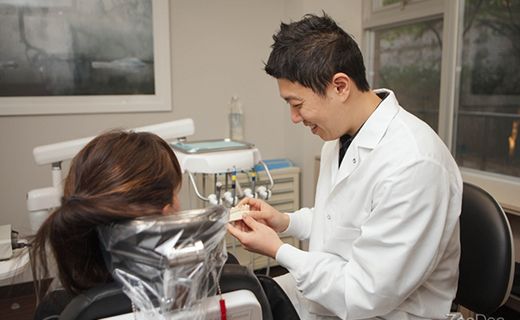 Payment Information
Payment Information
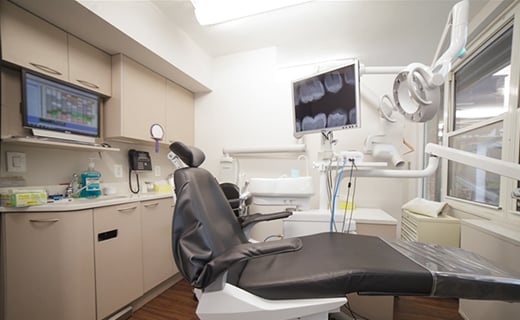 Insurance Options
Insurance Options
 CareCredit Dental
CareCredit Dental
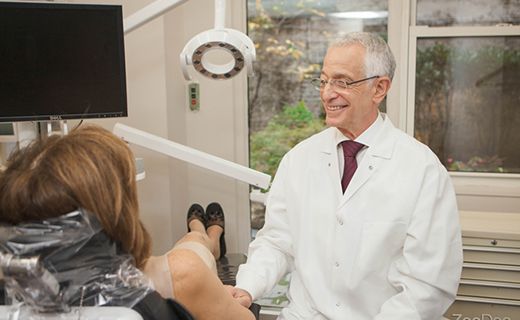 Appointment Policy
Appointment Policy
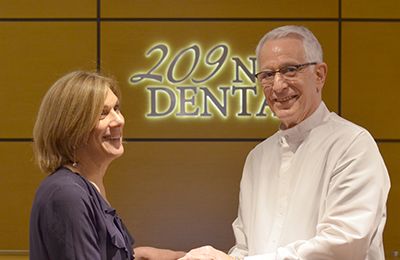 Free Consultation
Free Consultation
 Complimentary Teeth Whitening
Complimentary Teeth Whitening
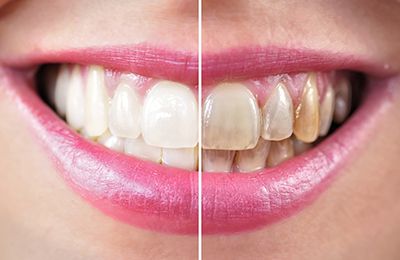 Teeth Whitening
Teeth Whitening


